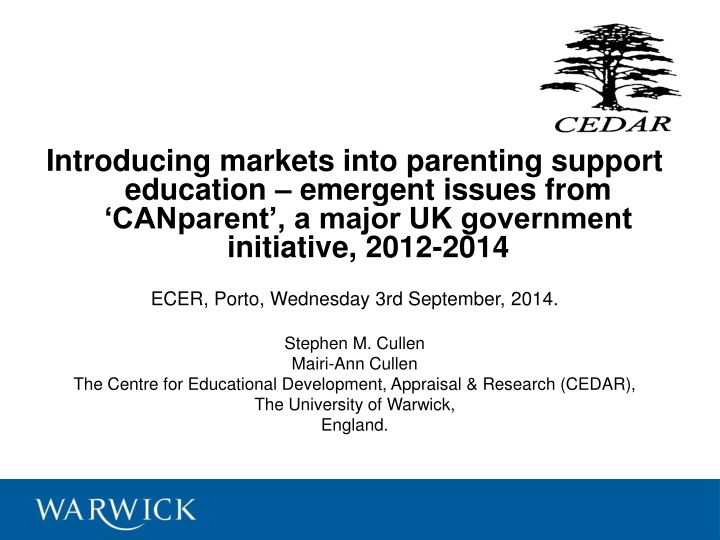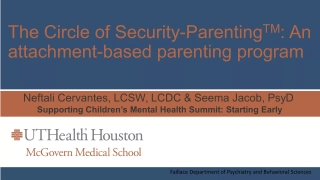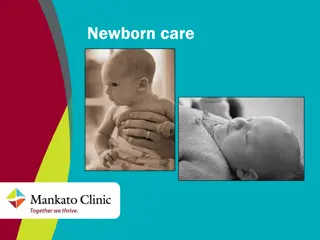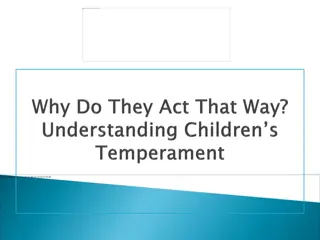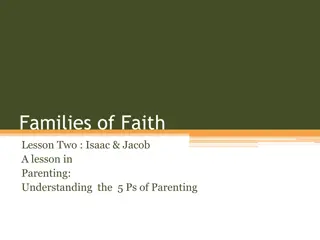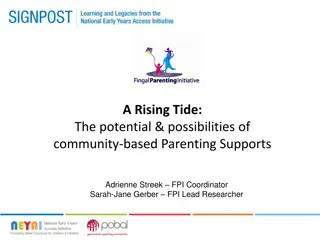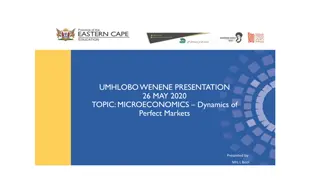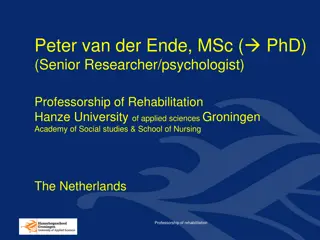Introducing Markets into Parenting Support: Insights from the CANparent Initiative in the UK
Exploring the integration of markets into parenting support within the context of the CANparent initiative in the UK between 2012-2014. The presentation delves into the meaning of markets, aspects of the CANparent initiative, nature, and limitations of market elements, and future pathways. It also discusses the landscape of parenting support in England, existing programs, delivery mechanisms, and the influence of austerity measures on social policy funding.
Download Presentation

Please find below an Image/Link to download the presentation.
The content on the website is provided AS IS for your information and personal use only. It may not be sold, licensed, or shared on other websites without obtaining consent from the author.If you encounter any issues during the download, it is possible that the publisher has removed the file from their server.
You are allowed to download the files provided on this website for personal or commercial use, subject to the condition that they are used lawfully. All files are the property of their respective owners.
The content on the website is provided AS IS for your information and personal use only. It may not be sold, licensed, or shared on other websites without obtaining consent from the author.
E N D
Presentation Transcript
Introducing markets into parenting support education emergent issues from CANparent , a major UK government initiative, 2012-2014 ECER, Porto, Wednesday 3rd September, 2014. Stephen M. Cullen Mairi-Ann Cullen The Centre for Educational Development, Appraisal & Research (CEDAR), The University of Warwick, England.
Overview Context: parenting support in England Context: austerity & UK government standpoint The CANparent initiative, 2012-2014 CANparent and the market, or quasi-market? Meaning of the market Market aspects of CANparent Nature & limitations of these aspects of CANparent Parenting class providers & the market Barriers & opportunities in relation to the market & CANparent Future pathways in relation to the CANparent initiative.
Context: parenting support in England 1) What do we mean by parenting support ? Parenting support. A basic definition: the provision of parenting information and advice services to support parents to communicate better with their children, encourage good behaviour, & prevent the development of later problems. Methods: face-to-face classes ; by telephone, written, on-line, or a combination of these.
Context: parenting support in England 2) What provision exists? Programmes: many parenting programmes have been developed, particularly over the last 40 years; especially following the development of behavioural models of child treatment derived from learning & social theories. Large numbers of programmes are home grown and, often, not evidence based. Others are evidence based, e.g. Triple P ; Incredible Years ; Strengthening Families ; FAST
Context: parenting support in England 3) What provision exists? Delivery of programmes in England is through a wide range of voluntary (third sector), local authority (LA), & health agencies. Delivery is often targeted at families deemed to be at risk of poor outcomes and/or anti-social behaviour. In the case of targeted provision, the cost is often borne by LAs and central government.
Context: austerity & UK government standpoint 2010 date: UK coalition government (Conservative & Liberal Democrat), with responsibility for England. Following the financial crisis of 2007-08, governments entered a period of austerity. This acted as an incentive to investigate new funding mechanisms in terms of social policy, for example, Social Investment Bonds (SIBs), Payment by Results (PbR), and the marketisation of service delivery fits with the neo-liberal approach. The outcome in terms of parenting support was the CANparent initiative ..
The CANparent (CANp) trial, 2012-2014 CANp trial = government trial of the market potential for universal parenting classes to support parents of 0-5 year old children. In 3 English areas Camden, Middlesbrough, High Peak use of vouchers was trialled to stimulate supply & demand in respect of universal parenting. All parents of 0-5s in those areas entitled to a voucher worth 100 to use for a CANp class. Providers received 75 for every parent recruited & another 25 on parents completion of the class.
Market The model of perfect competition a benchmark for markets: Numerous buyers & numerous sellers = both are price takers, the price being set by the interaction of both in the market place. Prices are therefore signals to buyers & sellers; & lead to entry/exit from the market.
quasi-market CANp the price was fixed, as were the numbers of providers in each area. There were 14 providers in total, each of which had bid for inclusion in the trial. In addition, the providers were supported by voucher distributors, local support, a website, & some national media coverage. The use of vouchers, the support elements, & the limit on the numbers of providers, meant that CANparent was a trial of a quasi-market model.
Nature & limitations of the CANp market There were clear market elements, particularly on the buyers (i.e. demand) side. All parents potentially had access to a voucher & could redeem it for any CANp class on offer. (They were not, however, allocating their resources by this, as the voucher could only be exchanged for a CANp class). However, on the supply side, matters were less clear, and issues emerged in relation to the provision of evidence based parenting support in response to a market-like system. This is the focus here.
Parenting class providers & the CANp model (i) The evidence base here: Qualitative research undertaken with the lead personnel of the 14 providers. The leads were interviewed at 3 stages (Time 1, 2 & 3) in the trial summer 2012, February 2013, Nov/Dec 2013). The 42 interviews were conducted by telephone or face to face, recorded (with informed consent) & fully transcribed. The interviews were semi-structured & analysed by thematic analysis. The transcriptions were coded individually against pre-determined themes (deductive analysis) & emergent themes revealed by transcription analysis (inductive analysis). The development of the coding system was an iterative process.
Parenting class providers & the CANp model (ii) Considering three areas: a) Providers approaches to universal parenting support, both non-market & market. b) Barriers & opportunities in relation to market provision of parenting classes in CANparent. c) Future pathways for universal parenting support education in relation to CANparent findings.
Providers initial (Time 1) view of universal parenting support, both non-market & market (i) Typically, the providers had delivered parenting support that was free at the point of delivery, with costs being met by grants, or providers core funding. This background and attitude to the provision of what was seen to be an educational, or health, service, impacted on providers readiness to engage with the CANparent market .
Providers initial (Time 1) view of universal parenting support, both non-market & market (ii) Although all the providers actively sought to be involved in the CANparent trial, few were aligned with market provision at the beginning. The majority did not have a predominantly market-orientated approach to parenting support as part of CANparent. Other motivations at the outset included: defensive strategies to protect providers existing provision against new entrants desire to acquire government recognition using CANparent as part of a wider strategy using CANparent as a trial space to try new methods/forms of provision support for universal provision.
Providers developing (Time 2) view of universal parenting support, both non-market & market (i) Only a minority of provider accepted the attempt to create a market. The majority of providers were resistant to the trial s version of marketised provision. There was criticism of constraints, e.g., targets, numbers of providers, which had been set in a non-market fashion. It was argued that collaboration rather than competition might be a better way to ensure universal provision & take up of that provision. At Time 2 the majority of providers reported difficulties in making the transition from upfront funding to take-up driven funding i.e., the CANparent model.
Providers final (Time 3) view of universal parenting support, both non-market & market (i) During the course of the trial 2 of the 14 providers withdrew. The remaining 12 providers continued to support universal provision strong, value-based reason for entering the market . Universal provision was seen as a way of normalising parenting support, reducing stigma, & enabling targeted provision to be more focused. There continued to be problems related to a market approach with continued resistance to the idea of direct selling to parents. But there was recognition that CANparent had encouraged providers to begin to think in a market-orientated fashion.
Barriers & opportunities in relation to market provision of parenting classes in CANparent (i) Main market-based incentives to enter the market : the voucher subsidy the size of the potential market Providers business models were based on government s planning assumption of a 40% take-up in eligible population i.e. that about 20000 parents would enrol
Barriers & opportunities in relation to market provision of parenting classes in CANparent (ii) Adopted different positions regarding risk Risk-willing; risk-averse; risk covered Some developed increased responsiveness to parent ( customer ) wishes as to when & where classes were held and developed their range of products e.g. shorter versions; online versions True potential take-up closer to 10% than 40% and turning potential to actual enrolment required effort Biggest barrier upfront costs of investing in marketing of universal classes and in face-to-face engagement of parents to attend
Barriers & opportunities in relation to market provision of parenting classes in CANparent (iii) Sense that majority of parents did not regard professional parenting support as relevant to them Reaching the point where attending a parenting course becomes the norm still a long way off culture change required over 10-15 years (as has happened with child care in UK) Sense that only a minority of parents would be able and willing to pay a price that covered costs mixed funding models seen as way forward The voucher trial had been an opportunity for providers to think in a more business-orientated way, to calculate costs, to think about marketing and to develop their products : new courses, new delivery platforms (e.g. online), new delivery modes (e.g. blended online and live), diverse ways of engaging parents
Future pathways for universal parenting support education in relation to CANparent findings Following the end of the CANparent trial in March 2014, the UK government funded another year of the trial CANparent Year 3 -, but this did not include the voucher for parents. Instead, a more clearly market approach - providers are either seeking funding from parents or from other organisations, including the voluntary and community sector, or by being commissioned by, e.g., public health services. However, initial data collection from the 5 providers involved shows that direct selling to parents will be only a small element, and funded provision will be more usual.
Issues/questions Are there any examples of market-based parenting courses in your country? How appropriate is it to try to normalise the concept of universal parenting support? How appropriate is it to ask parents to buy parenting support?
Relevant reports CANparent trial evaluation: final report (Geoff Lindsay, Mairi Ann Cullen, Stephen Cullen, Vaso Totsika, Ioanna Bakopoulou, Susan Goodlad, Richard Brind, Emily Pickering, Caroline Bryson, Susan Purdon, Gavan Conlon, Iris Mantovani), Department for Education, July, 2014, Ref: DFE- RR357: https://www.gov.uk/government/publications/canparent-trial-evaluation-final-report CANparent trial evaluation: final report brief (Geoff Lindsay, Mairi Ann Cullen, Stephen Cullen, Vaso Totsika, Ioanna Bakopoulou, Susan Goodlad, Richard Brind, Emily Pickering, Caroline Bryson, Susan Purdon, Gavan Conlon, Iris Mantovani), Department for Education, July, 2014, https://www.gov.uk/government/uploads/system/uploads/attachment_data/file/332184/RB357_- _CANparent_trial_evaluation_final_report__Research_Brief_08_07_14.pdf (8 pp). CANparent Trial Evaluation: Second Interim Report, (M-A. Cullen, S. Cullen, S. Strand, & G. Lindsay), Department for Education, Research Report DFE-RR317, ISBN: 978-1-78105-288-4, January, 2014: https://www.gov.uk/government/publications/canparent-trial-evaluation-second-interim-report CANparent Trial Evaluation: First Interim Report, (M-A Cullen, S. Cullen, S. Strand, I. Bakopoulou, G. Lindsay, R. Brind, E. Pickering, C. Bryson, & S. Purdon), Department for Education, Research Report DFE-RR280, ISBN: 978-1-78105-223-5, March 2013: https://www.gov.uk/government/publications/canparent-trial-evaluation-first-interim-report
